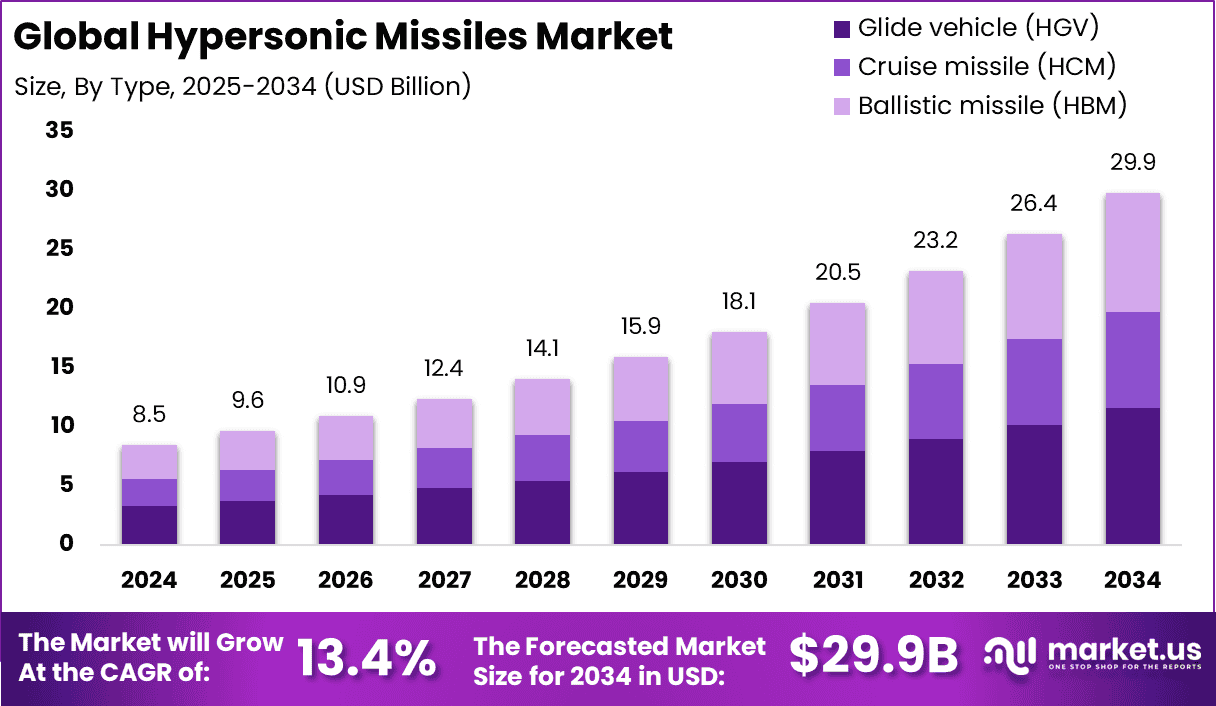Table of Contents
The global Hypersonic Missiles market was valued at approximately USD 8.5 billion in 2024 and is forecast to expand significantly to around USD 29.9 billion by 2034, registering a robust CAGR of 13.4% from 2025 to 2034. North America dominates the landscape with a 34.6% market share in 2024, generating nearly USD 2.9 billion in revenue. This rapid growth is driven by heightened geopolitical tensions, strategic defense modernization, and significant investments in hypersonic technologies that offer superior speed, accuracy, and evasion capabilities compared to traditional missile systems.

How Tariffs Are Impacting the Economy
Tariffs on critical raw materials and aerospace components essential to hypersonic missile development have exerted considerable pressure on manufacturers. Metals like titanium and specialized alloys used in hypersonic airframes and propulsion systems are subject to tariffs, increasing costs by 8-15%. This rise in input prices constrains manufacturers’ profit margins and slows production timelines, thereby affecting defense procurement budgets.
➤ Discover how our research uncovers business opportunities @ https://market.us/report/global-hypersonic-missiles-market/free-sample/
Additionally, retaliatory tariffs and trade restrictions imposed by key international players complicate supply chains, especially for microelectronics and high-precision sensors. These tariff-induced disruptions delay the delivery of advanced missile systems to defense agencies and may prompt governments to reconsider procurement strategies or increase defense spending to offset cost escalations. Overall, tariffs introduce volatility and uncertainty in a market reliant on timely innovation and deployment.

Impact on Global Businesses
Rising Costs & Supply Chain Shifts: Businesses face increased costs due to tariffs on critical components, forcing many to diversify supply chains away from tariff-heavy countries. This shift incurs restructuring costs and extended lead times.
Sector-Specific Impacts:
- Aerospace Materials: High tariffs on titanium and alloys inflate raw material costs.
- Electronics & Sensors: Dependence on foreign microchips faces tariff-related price hikes.
- Defense Contractors: Increased production costs may reduce margins and delay project timelines.
- International Collaborations: Export restrictions complicate partnerships and joint ventures.
Businesses are adopting regional sourcing, investing in local manufacturing, and innovating material science to mitigate tariff impacts.
Strategies for Businesses
To navigate tariff challenges, companies are focusing on:
- Supply Chain Diversification to reduce dependence on high-tariff regions.
- Localizing Production to meet government incentives and avoid tariffs.
- Investing in R&D for alternative materials and propulsion technologies.
- Enhancing Digital Supply Chain Management for agility and cost control.
- Forming Strategic Alliances to share technology and reduce costs.
These strategies enhance resilience and maintain competitive advantage in a volatile trade environment.
Key Takeaways
- Hypersonic missiles market growing at a CAGR of 13.4%, expected to reach USD 29.9 billion by 2034.
- North America leads with a 34.6% market share in 2024.
- Tariffs on metals and electronics increase manufacturing costs.
- Supply chain diversification and domestic manufacturing mitigate risks.
- Innovation in materials and digital supply chain is key for growth.
➤ Get full access now @ https://market.us/purchase-report/?report_id=148434
Analyst Viewpoint
The hypersonic missiles market is currently challenged by tariff-induced cost pressures and geopolitical trade tensions. However, the long-term outlook remains positive due to accelerating government investments in next-generation defense technologies. Analysts foresee rapid adoption of advanced propulsion, AI-guided systems, and hypersonic platforms to counter emerging threats. Businesses prioritizing supply chain flexibility and technology innovation are expected to dominate. Growing emphasis on self-reliance and regional manufacturing will reduce tariff vulnerabilities, further supporting sustainable growth in the coming decade.
Regional Analysis
North America commands the hypersonic missile market with strong government funding and advanced aerospace R&D infrastructure. Europe is accelerating its hypersonic programs amid rising security concerns. Asia-Pacific, led by China and India, is investing heavily in hypersonic technology to strengthen regional defense capabilities. Latin America and the Middle East are nascent but emerging markets, driven by growing defense budgets and geopolitical instability. Regional trends favor increased localization, joint ventures, and export control compliance.
➤ Discover More Trending Research
- Voice-Activated Apps Market
- Sea Drones Market
- Multi Screen Advertising Market
- Earthquake Insurance Market
Business Opportunities
Emerging opportunities include developing hypersonic propulsion systems, AI-enabled guidance, and counter-hypersonic defense technologies. There is rising demand for modular and scalable missile platforms tailored to diverse operational needs. Defense contractors and technology firms can capitalize on expanding government contracts, particularly in Asia-Pacific. Growth in software-defined weapons and digital supply chains also opens new avenues. Collaborations with space agencies for hypersonic missile testing further broaden potential revenue streams.
Key Segmentation
The hypersonic missile market is segmented by:
- Type: Boost-Glide Vehicles, Cruise Missiles
- Propulsion: Scramjet, Rocket Engine
- Range: Short Range, Medium Range, Long Range
- End-User: Military, Defense Agencies, Homeland Security
- Region: North America, Europe, Asia-Pacific, Latin America, Middle East & Africa
These segments guide tailored product development and targeted market strategies.
Key Player Analysis
Leading companies focus on enhancing propulsion technology, stealth capabilities, and AI integration. Heavy investment in R&D supports breakthroughs in speed, range, and guidance accuracy. Firms emphasize collaborations with governments and research institutions to develop next-gen hypersonic platforms. Supply chain resilience, export compliance, and innovation in digital manufacturing are critical competitive factors. Leaders also explore dual-use technologies, expanding applications beyond military to space exploration and surveillance.
Recent Developments
Recent breakthroughs include successful test flights of scramjet-powered missiles, integration of AI for precision targeting, and partnerships for joint development of hypersonic defense systems. Increased defense budgets have accelerated prototype deployments.
Conclusion
The global hypersonic missile market is poised for rapid growth, driven by strategic defense priorities and technological advances. While tariffs pose challenges, businesses adapting through innovation and supply chain agility will capitalize on expanding opportunities worldwide.
Discuss your needs with our analyst
Please share your requirements with more details so our analyst can check if they can solve your problem(s)



